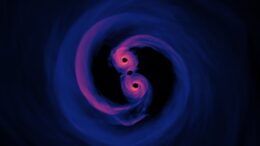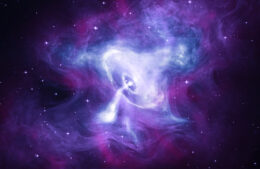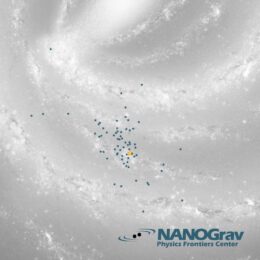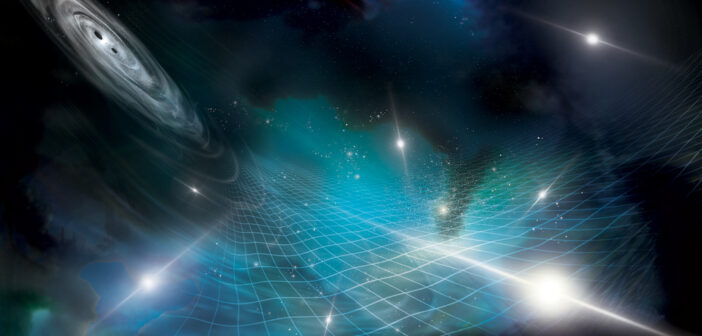For the first time, researchers using pulsar timing arrays have found evidence for the long-sought-after gravitational wave background. Though the exact source of this low-frequency gravitational wave hum is not yet known, further observations may reveal it to be from pairs of supermassive black holes orbiting one another or from entirely new physics at work in our universe.
A New Window onto Gravitational Waves
In 2016, researchers reported the first detection of gravitational waves by the Laser Interferometer Gravitational-Wave Observatory (LIGO), opening a new window onto a universe’s worth of collisions between extreme objects like black holes and neutron stars. Though this discovery marked the beginning of a new observational era, many sources of gravitational waves remained beyond the reach of our current detectors on Earth.

Visualization of a simulation of a supermassive black hole binary system. [NASA’s Goddard Space Flight Center/Scott Noble; simulation data, d’Ascoli et al. 2018]
Decades ago, researchers proposed that large numbers of stellar remnants called pulsars could provide a way to detect the low-frequency signal of the gravitational wave background. Today, several international collaborations announced their discovery of significant evidence for the gravitational wave background as seen by pulsar timing arrays.
Keeping Time with the Best Clocks in the Universe
Let’s break down exactly what that means, starting with the precise timing of pulsars. Pulsars are extremely dense, rapidly spinning remnants of massive stars that exploded as supernovae. Just one teaspoon of pulsar matter, brought to Earth, would weigh billions of tons. As pulsars spin, they emit narrow beams of radio waves along their poles. When these beams sweep past Earth, we detect the pulses of radio emission from which pulsars get their name. Typical pulsars spin once every few seconds to milliseconds, and they do so with incredible regularity, varying by only one part in 10 quadrillion from pulse to pulse.

A composite X-ray, optical, and infrared image of the Crab Nebula, which is energized by the pulsar at its center. [X-ray: NASA/CXC/SAO; Optical: NASA/STScI; Infrared: NASA-JPL-Caltech]
An Array of Spinning Stars
In reality, there are several reasons why an individual pulse’s arrival time at Earth might vary. The many light-years between us and these radio beacons is filled with ever-shifting clouds of gas and dust, which scatter and delay radio signals. Many millisecond pulsars are constantly swinging in a gravitational dance with their stellar companions. Some pulsars also undergo sudden increases in their spin rate, called glitches, due to starquakes or changes in their interiors.
This is where keeping tabs on many pulsars at once comes in handy. If you survey a collection of pulsars scattered across our galaxy, intervening dust or glitches will affect some pulsars and not others. Gravitational waves from distant sources, on the other hand, send ripples through spacetime that will affect the pulse arrival times of widely separated pulsars in a coordinated way. By searching for correlations among the arrival times of pulses from dozens of pulsars at once — i.e., using a pulsar timing array — researchers hope to uncover the signature of gravitational waves.
Bringing the Background to the Foreground

Locations of pulsars (blue stars) in the NANOGrav pulsar timing array relative to the location of the Sun (yellow star). Some pulsar locations are approximate. Click to enlarge. [NANOGrav]
Over the past 15 years, the NANOGrav collaboration has collected radio data from 68 pulsars in the Milky Way to search for gravitational waves. This long baseline of observations is necessary to capture the years- or decades-long undulation of gravitational waves from circling supermassive black holes.
Not only does the search for the gravitational wave background require years of observations, it also needs the utmost precision: the signal caused by passing gravitational waves is incredibly small, causing spacetime to stretch or compress by just one part in one quadrillion. This is far smaller than the normal fluctuations in an individual pulsar’s timing due to intervening gas and dust.

Observed correlation between pulse arrival time discrepancies (blue points) and the correlation predicted by general relativity from a background due to supermassive black hole binaries (black dashed line). [NANOGrav]
Are supermassive black hole binaries the only possible source of the gravitational wave background? No, though they’re still the leading candidate; the NANOGrav team reports that their observations are consistent with black holes that sink toward each other purely due to emitting gravitational waves as well as those that are interacting with their environment, engulfing and flinging nearby gas as the black holes swing around each other. However, exotic new physics, such as certain cosmic inflation scenarios or the existence of ultra-light dark matter, are a potential source as well. Some of these new physics models fit the data better than models of supermassive black hole binaries do, but the team notes that the models rely on major assumptions that are not yet proven valid.
From Evidence to Detection
The NANOGrav collaboration has been careful to refer to their findings as evidence for the gravitational wave background rather than a detection of it. What’s needed to push this discovery into coveted 5-sigma territory? Luckily, the answer is probably just that we need more time — time for the NANOGrav team to combine their observations with those of other pulsar timing array collaborations, or simply time to let the already impressive 15-year baseline of the project increase. In addition to declaring a firm detection of the gravitational wave background, the NANOGrav team expects that future observations should allow us to disentangle the source of the background hum and even pinpoint individual supermassive black hole binaries for further study. It’ll be fascinating to watch the frontier of this new field advance in leaps and bounds!
For more information, check out the Focus Issue in the Astrophysical Journal Letters here: Focus on NANOGrav’s 15 yr Data Set and the Gravitational Wave Background
Citation
“The NANOGrav 15-year Data Set: Evidence for a Gravitational-Wave Background,” Sarah Vigeland et al 2023 ApJL 951 L8. doi:10.3847/2041-8213/acdac6
“The NANOGrav 15-year Data Set: Observations and Timing of 68 Millisecond Pulsars,” Joseph Swiggum et al 2023 ApJL 951 L9. doi:10.3847/2041-8213/acda9a
“The NANOGrav 15-Year Data Set: Detector Characterization and Noise Budget,” Jeffrey Hazboun et al 2023 ApJL 951 L10. doi:10.3847/2041-8213/acda88
“The NANOGrav 15-year Data Set: Search for Signals from New Physics,” Andrea Mitridate et al 2023 ApJL 951 L11. doi:10.3847/2041-8213/acdc91

